End of the road or not, It is the new era of US-China relations to watch...
Takeaways from the Intellectus Partners Investment Committee for the week ending Nov 2,2018:
At this meeting our mission was to attempt to take a hard look at whether or not we are entering the “End of Cycle” period for the economy and thus the Bull Market that begin in 2013. The Intellectus very bullish call in the Fall of 2016 positioned us well for the run that followed. To see a meaningful correction post a move like that is not surprising. Our Investments & Allocations have had excellent success since our launch three years ago we and want to make sure that we continue to be prudent in protecting all of the profits we have created.
Our opinion is that, while there are certainly stresses that are appearing in more places, it appears that this current correction will likely be deeper than most. But, the current evidence suggests that we are closer to a mid-cycle phase than not. We are clearly in a large new cycle of innovation in the global economy which increases the risks to old “established” companies and business models that fail to innovate. This generally alters the markets response to typical cyclical indicators, and counter intuitively increases volatility. The extensive run in most asset classes also generally sets up periods of volatility. We have seen some areas of speculation (Bitcoin, Crypto and Cannabis come to mind). The IPO market has been as wide open as it has been in years (In fact, the number of unprofitable IPO’s is also at a record), and this itself has increased supply of shares. But there are reasonable counter arguments against these being signs of the top. It has been a very very long time since we have seen a well functioning IPO market, so there really is just a lot of pent up demand for growth stocks. Mergers and Acquisitions are rather tame at this point. We have not seen the commensurate bubble of activity there. The consumer is not over levered and is in very good shape in the US but leverage does indeed reside in Government coffers.
There are some data and indicators that we do not like and are worth monitoring closely. This includes : Some weakening Macro data, The action in the Housing stocks, Auto sector and Banks. These groups are all areas that are very economically sensitive and they are not acting well at all. So, they are indeed “tells” as to the health of the economy. But, there are some unusual reasons that may explain their weakness.
In Housing, the builders are suffering from a millennial generation that prefers renting to buying. The 2018 Tax law that went into place made housing far more expensive (especially in high growth areas, such as the coasts). The elimination of the SALT deduction and the limitations on mortgage deductibility as significant. Finally, the rising level of mortgage rates is compounding the cost squeeze. In the Auto sector, I think it is too early to call it the “Tesla Effect”, but they are clearly taking share from the old ICE car makers. More specifically, the auto makers are far behind in the technology curve, The wave of innovation is not helpful to these companies. They are starting to look a lot like Blockbuster, Barnes and Noble or Sears . Between Electric and the coming of Autonomous they are scrambling to stay relevant…and not faring well. On top of that the Ride Share industry has put into question the validity of even owning a car in the first place. As for Banks, this is a bit more of a conundrum. They are generally very cheap, are in fact growing(now) and their balance sheets are the best that they have been in a generation. The FED raising rates does help their Net Interest Margins quite a bit. But, again they are suffering from massive change, in both technology and business models. But either way, they also are being “Out Innovated”. Just look at the Independent RIA movement, It has attracted many hundreds billions of dollars of assets and all of the best talent way from banks. FinTech is exploding everywhere. Shadow banking is coming from many new places. All of this is chipping away at the carcasses of the old stodgy banks.
The Macro areas of risk which we have decided to focus upon are 1. Is the FED is a bit too tight? 2. Mid Terms are creating some concern of a change in fiscal policies 3. Liquidity is still an issue in the markets, and most importantly….4. China.
Before we get into the details, there are some relevant observations. One is that there is clearly not yet a market consensus as to just why this all flared up as it did, when it did. The relatively fast and severe correction put us into oversold territory very quickly. Earnings that have been reported through the Q3 reporting season have been spectacular. But we are seeing far more muted guidance than the market had anticipated. The Macro-economic data that we have been seeing is supportive in the US, but weak everywhere else. The US Dollar strength is an outlier to the general action as is the relative stability in Yields. Company profits are good, surprisingly, even in many areas outside of the US
This all began on October 3. That day Fed Chair Powell was quoted as saying the U.S. economy is experiencing “a remarkably positive set of economic circumstances,” suggesting that he sees little risk the current economic expansion will be knocked off course……“There’s no reason to think this cycle can’t continue for quite some time, effectively indefinitely,” Mr. Powell said in a moderated discussion with PBS News Hour’s Judy Woodruff, at the Atlantic Festival in Washington.
As the WSJ said, Mr. Powell’s comments echoed remarks he made Tuesday, where he said he doesn’t see evidence the labor market is at risk of overheating or of price pressures accelerating. He also pushed back Tuesday against criticism that Fed officials are underestimating the prospect of inflation overshooting the central bank’s 2% goal.
Then the China situation went from a “Trade War” to much more. On the very next day October 4, Vice President, Mike Pence gave a rather aggressive speech on China relations and their economic policies. It was made abundantly clear in that speech if it was not already, that It’s no longer just a “trade war”! What has evolved in the US-China relationship is far beyond that. This is likely developing into an all-out Economic Cold War.
We view the beginning of the selloff clearly being triggered by the VP Michael Pence speech on the heels of Powell’s Uber bullish comments (which implies more hawkish FED actions) the day before…..Now the markets had to recalculate risks. If it were just the FED being too tight, then any weak economic data would be helpful. But, if it is the increasing tension with the world’s second largest economy, we have to be wary of weaker economic data-points. So, there is not a natural push-pull. These are two very opposing forces.
Per the Brookings institution , in his speech VP Pence “drew an implicit comparison to Nazi Germany and Imperial Japan by warning about the historic pattern of countries that pair oppression at home with ambition abroad. He accused China of using “debt-trap diplomacy” to expand its influence.” They continue “…the vice president’s speech was not a search for off-ramps or for lowering tensions, but rather a message of America’s determination to elevate pressure until Beijing accepts the bilateral relationship, as Washington envisions it. It also signaled that the White House does not believe a de-escalation on trade is achievable or desirable in the near term.” Per the Eurasia Consultancy group…” "much of the tariff dispute centers on the US-China technology and innovation rivalry, which has a strong link to national security concerns and military competition between the two countries," the consultancy added.”
Not so coincidentally, on Oct 4th Bloomberg released a story about a small company called SuperMicro. https://www.bloomberg.com/news/features/2018-10-04/the-big-hack-how-china-used-a-tiny-chip-to-infiltrate-america-s-top-companies. In it they claimed that the company was installing chips onto the devices at both Apple and Amazon in a corporate espionage plot. Since the day of the release, both Amazon and Apple have very publicly denied these claims. Could this story have been a plant to ramp up pressure on China? In retrospect, it appears that may be the case. It certainly had an impact on the share prices of Global Technology companies share prices.
Then on Oct 12, https://www.defensenews.com/naval/2018/07/07/us-navy-destroyers-make-a-rare-passage-through-the-taiwan-strait/ the US sailed two guided missile warships through the strait of Taiwan. This was the second show of “force” in this manner by US ships this year and the first time in over a decade. China called the flights "provocative," and warned the US that it would take "necessary measures" to defend Chinese interests. Several days later, the Chinese military conducted drills in the South China Sea. There are now rumors of advanced war game like show of force in the South China Sea. Are weak. The markets are rightly uncomfortable with this.
All of this is happening while the Chinese economy is struggling. The national economic data coming from China continues to be soft. So, the US is clearly trying to put maximum pressure on China while they are relatively weaker. Given the intimate relationship that some of the highest growth areas of our economy have with China, Tech in particular, it is not surprising that Technology companies, and specifically Semiconductors are taking this all very hard.
![]
It is our view that the rising China-US Geopolitical tensions are THE guiding force for the markets.
On a day to day basis, it is mostly the news that comes out related to China that is driving the moves in the markets. US corporations direct sales exposures to China is rather small, but not the case ex US. This also helps to explain the significant weakness that we have been seeing all year in Emerging markets. What is a bit surprising, is that this has not yet affected consumer confidence and behavior. It is worth closely monitoring and parsing the statements that come out of each administration with regards to their positioning on economic matters. If we see implied or overt concessions and/or more pro-growth reform from China, the markets will likely respond very favorably.
Additionally, and less surprisingly we saw a “liquidity crunch” in the momentum side of the markets. Many of the largest Quantitative Hedge Funds are having a difficult year. The liquidation that we have been seeing in the highest growth stocks is likely coming from a forced liquidation sequence within these funds. China and Momentum as a factor within these models is clearly impacting volatility. According to Bespoke, the 50 stocks that were up the most YTD heading into October fell an average of 10.66% during the month, while the 50 worst fell 7.09%. per Bespoke “Another noteworthy characteristic is analyst ratings. You might expect the stocks with the highest percentage of “Buy” ratings to hold up a little better in a down market, but they actually took it on the chin, while the worst rated (or most unloved) stocks by analysts outperformed”. The late quarter snap back on the same names further supports this thesis. These types of liquidity traps often take 2-6 weeks to work their way through the system.
So, In spite of robust earnings reports, we do think that it is prudent to expect the volatility to continue. While we are indeed oversold, sometimes, momentum to the downside can in fact be exacerbated by oversold conditions. In 1997-98 we had the Thai Bhat crisis/Russian & LTCM default. During this period the SP500 had a 20% correction. On a tactical basis, if the SP500 cannot retake the 200 Day Moving Average, the market will likely be sold on rallies and show continued weakness. It is not implausible to think that we could see a move of similar magnitude if one of a few things happen, such as a crisis out of China, Italy, Deutsche Bank or an as yet, “unknown” catalyst. If that were to happen, we are confident that there will be an entire new set of investment opportunities opening up.
As far as earnings are concerned, below is a rather amazing slide (all charts courtesy of Bloomberg LLP). This is the three year forward earnings, cash flow and sales growth of the Russell 2000. This is, of course a broad barometer of US economic growth and the success that US companies are currently having. As you see the expected growth is very robust.
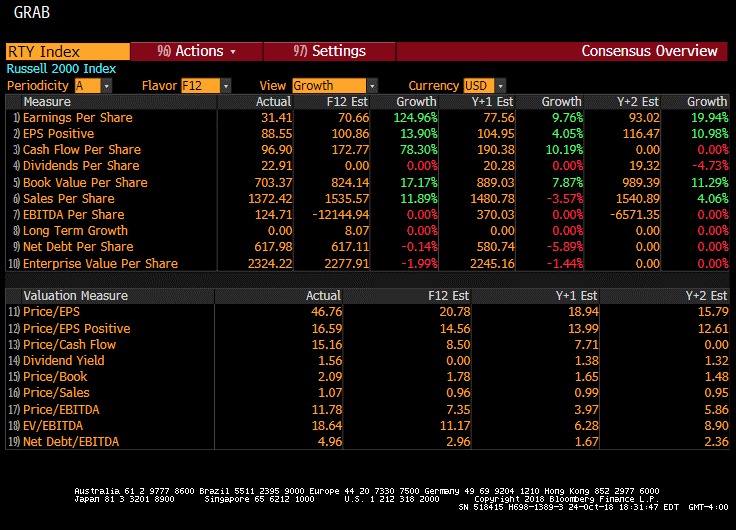
Now, let’s take a look again at the broader and recent economic data reported. It is mostly good, but there are some signs of weakening data:
In a typical "Wall St vs Main Street" type of phenomenon, wages in the US are finally surging. The graphic below shows the recently reported Average Hourly wages are now at a 10 year high! This is obviously going to be of concern to the FED. During the Bull market, Wages was not a problem for policymakers. The question is, will the FED run the risk of squelching a metric that Main Street has been anxiously hoping for many years.
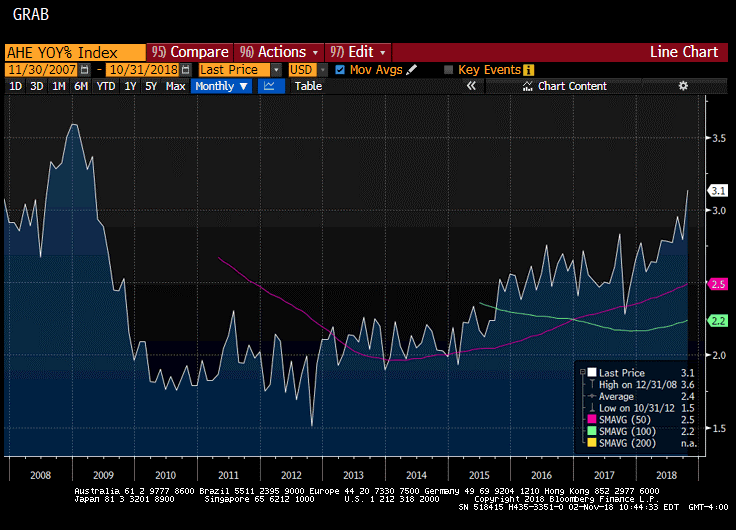
And specifically the Manufacturing sector continues its resurgence: Manufacturing payrolls, as seen below are strong:
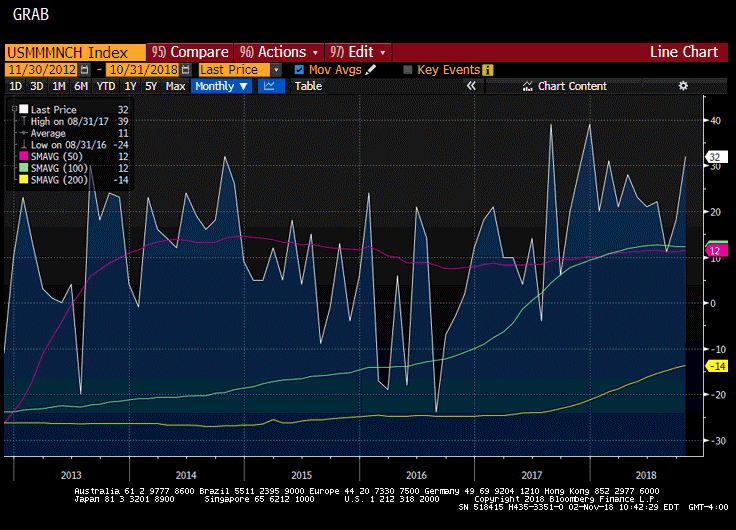
Here is a basic, simple internal LEI : US PMI, Current conditions index(orange), Retail Sales YOY, sp500, sp500 PE multiple(blue)....this shows really well and is relatively recent data. Note the 2015 "manufacturing recession" (white line-PMI) in there becomes obvious. That 2015 period should not be ignored. It supports the logic that we might in fact be more mid cycle than late cycle. Given that the manufacturing sector was literally in contraction just three short years ago
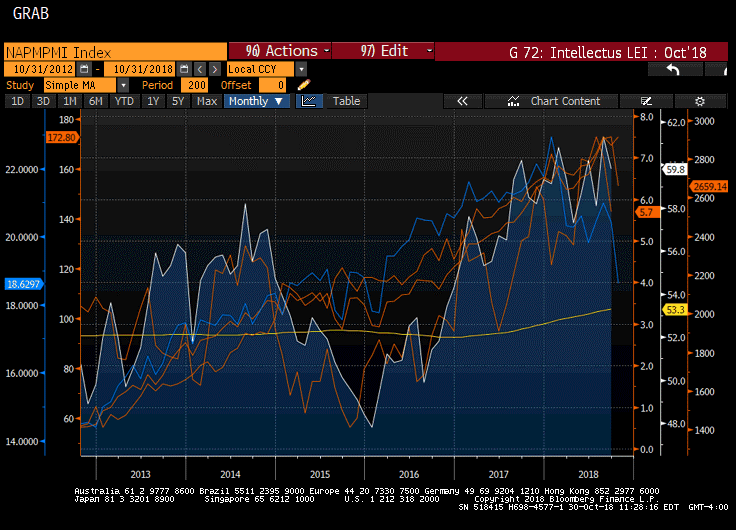
But…. in the following chart, New Orders reported this past week were the weakest in 2 years:

….And this one has us a bit concerned. Challenger Job Cuts announced has spiked to a multi year high. Of course it is possible that the impact of the recent hurricanes could have affected this, But the magnitude of the spike here is certainly worth watching. It is interesting to note that this is NOT supported by the other employment data(yet) such as the non farm payroll as well as the weekly data

Valuation: The chart below is a updated look at the Long Run Price/Earnings multiple of the SP500. Again, our view on this is that valuations are not the focus. We can show other metrics that look richer, such as price/ebitda and price/sales. But Price to earnings, and price to cash flows are still reasonable…as long as earnings continue to remain robust.
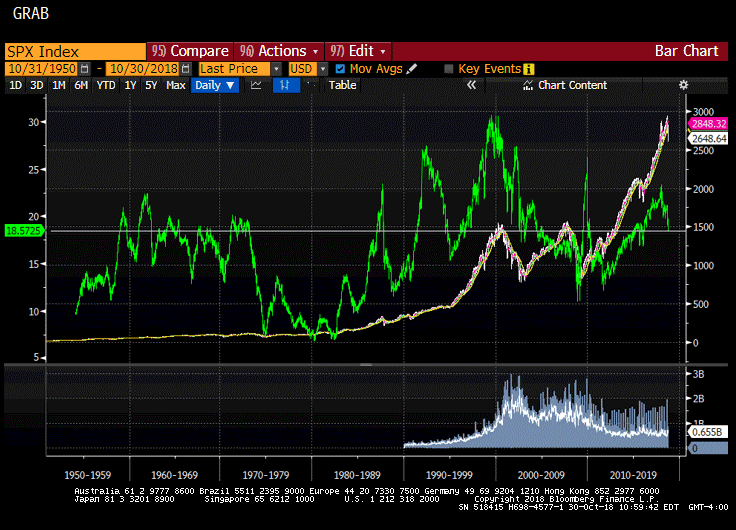
As far as what the volatility means in terms of forward returns: You can see in the last chart that in 9 of the last 9 periods where the NASDAQ volatility index(VXN) traded at a level above 30, the 6 and 12 month forward returns have been positive. In most cases, double digit returns. So, this bodes well for the forward returns once this correction clears.
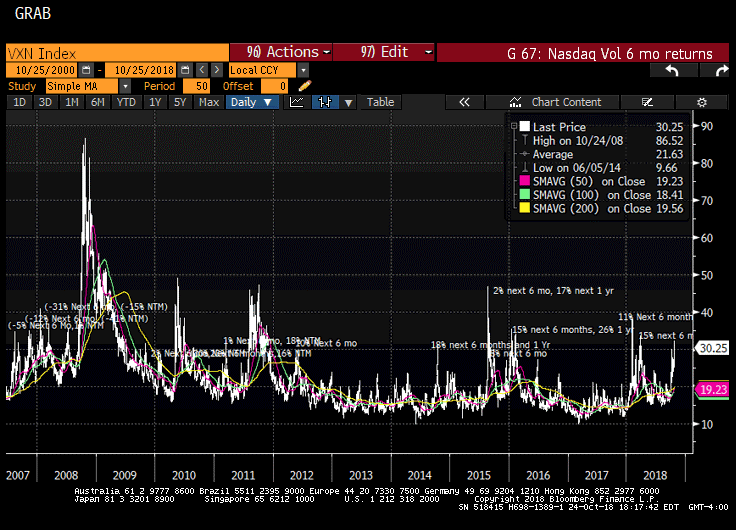
So, with all the recent turmoil that has arisen,the markets are looking for clarity. So, until that comes, it is a time to focus on Quality and monitor risk exposures. We view this period as an important phase in determining the slope and duration of this Bull Market. Our view that we are in a period that offers unique and numerous opportunities leaves us with a balanced approach to managing the current near term risks with the long run opportunities that are now and will soon open up.


Comments